Bánh Xèo (Savory Vietnamese Crepes)
Banh xeo, or mouthwatering Vietnamese sizzling crepes, is an aromatic turmeric-infused batter, with succulent pork and shrimp fillings, and vibrant herbs. Get ready to sizzle, flip, and wrap your way to a taste sensation that combines crispiness, fragrance, and savory goodness.

So, whether you’re hosting a dinner party or simply craving a culinary adventure in your own kitchen, banh xeo is the way to go. It’s a dish that’s sure to impress your family and friends while filling your home with delicious aromas and unforgettable flavors.
If you love banh xeo, try these mini versions called banh khot. It uses an identical batter and is topped with shrimp. Looking for more Vietnamese food? Try the most iconic Vietnamese Noodle Soup – Pho.
What is Banh Xeo?
Banh xeo is a popular Vietnamese dish that consists of a savory pancake filled with various ingredients. The name “banh xeo” translates to “sizzling pancake” or “sizzling cake” in English, referring to the sound the batter makes when poured onto a hot pan. It is a specialty in Vietnamese cuisine, particularly in the central and southern regions of Vietnam.
The pancake batter is made from a combination of rice flour, cornstarch, turmeric powder (which gives it a yellow color), coconut milk, and water. The batter is poured into a hot skillet or pan and cooked until it becomes crispy and golden. The pancake is usually large and thin, with a lacy, crepe-like texture.
Traditionally, banh xeo is filled with a combination of ingredients such as shrimp, slices of pork belly or pork loin, sliced onions, and bean sprouts. The fillings can vary based on personal preference and regional variations. The pancake is folded in half over the fillings to create a half-moon shape and is often served with fresh herbs like mint, cilantro, and perilla leaves.
Banh xeo is commonly enjoyed by wrapping a portion of the pancake, along with herbs and other fillings, in lettuce leaves or rice paper wrappers. It is often dipped in a tangy and savory dipping sauce (nuoc cham) made from fish sauce, lime juice, sugar, garlic, and chili.
Why you’ll love this recipe
- Crispy Texture: The hallmark of a good banh xeo is a perfectly crisp exterior. The crepe should have a delicate, lacy texture with a satisfying crunch when you bite into it. Achieving the ideal level of crispiness is a result of proper cooking techniques and the right balance of ingredients.
- Versatile Fillings: One of the wonderful aspects of banh xeo is the freedom it offers for customization when it comes to fillings. While the traditional combination of shrimp, pork, bean sprouts, and onions is undeniably delicious, you can unleash your culinary creativity and customize the fillings to suit your taste preferences.
- Interactive Dining Experience: Banh xeo is often served with lettuce leaves or rice paper wrappers. Diners can assemble their own rolls by wrapping pieces of banh xeo, fresh herbs, and lettuce, adding an interactive element to the meal.
- Gluten-Free Option: Banh xeo is naturally gluten-free since it’s made primarily with rice flour. This makes it a popular choice for individuals with gluten sensitivities or those following a gluten-free diet.
- Light and Refreshing: Despite its crispy exterior, banh xeo is a relatively light dish. It’s not overly greasy or heavy, making it a refreshing choice for a meal.
- Vietnamese Culinary Tradition: Banh xeo is a beloved dish in Vietnamese cuisine and has a long history and cultural significance. Exploring and enjoying banh xeo can provide a window into Vietnamese culinary traditions and the country’s rich food culture.
- Sharing and Socializing: Banh xeo is often served in larger portions, making it a great dish to share with family and friends. It’s great for parties and get-togethers.
What is the best pan for banh xeo?
When it comes to cooking these Vietnamese savory pancakes, the best pan to use is a non-stick skillet or a traditional cast iron pan. Both options offer their advantages, so you can choose based on your personal preference.
- Non-stick skillet: A non-stick skillet is a popular choice for making banh xeo because it prevents the pancakes from sticking to the pan and allows for easy flipping. The non-stick surface ensures the crepes cook evenly and develop a crisp exterior. Additionally, non-stick skillets are generally lightweight and easy to handle.
- Cast iron pan: A traditional cast iron pan can also be an excellent option for making banh xeo. Cast iron pans distribute heat evenly and retain it well, which helps in achieving a crispy texture. Cast iron pans are generally heavier compared to nonstick pans. This weight difference can have an impact when making banh xeo or any other dish that requires frequent flipping or maneuvering of the pan. However, it’s worth noting that the weight of the cast iron pan can also be seen as an advantage in some cases. The weight provides stability and even heat distribution, which helps in achieving a crisp and evenly cooked banh xeo. The heat retention of cast iron also contributes to the development of a desirable crust, adding flavor and texture to the dish.
Regardless of the pan you choose, make sure it has a wide surface area and a low rim. This design allows the banh xeo batter to spread evenly, resulting in a thin and crispy crepe.
Remember to preheat the pan adequately and add a sufficient amount of oil to ensure the crepes don’t stick and develop a crispy texture.
Ingredients and Substitutions
Please scroll ⬇️ to the recipe card to see the full ingredient amounts and instructions.
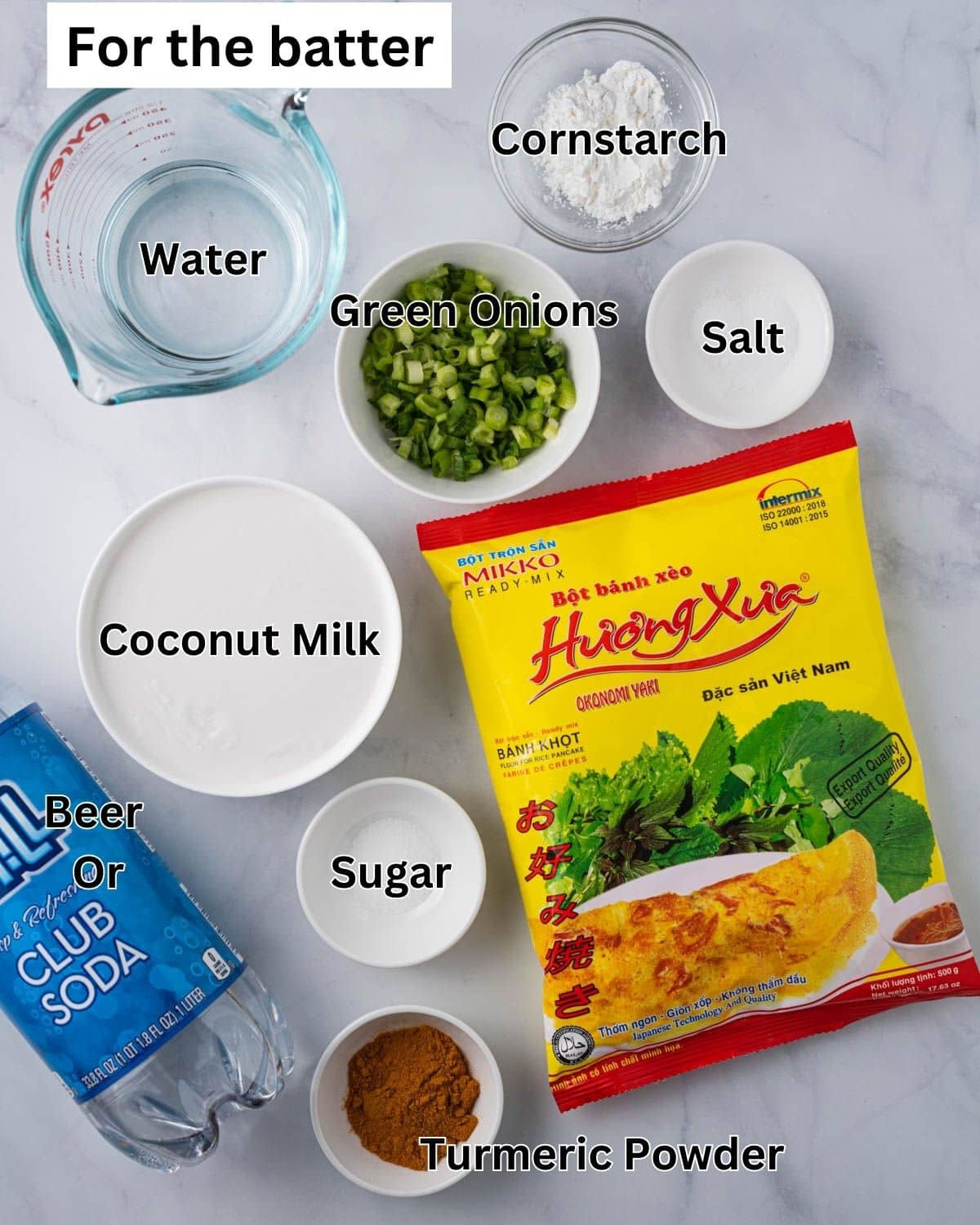
For the batter:
- Mikko Ready Mix (Bot Banh Xeo Huong Xua): This is premixed flour that combines rice flour, turmeric powder, and other ingredients needed to make banh xeo batter. You can find this at your local Asian grocery store or online. You can also use 3 1/2 cups of rice flour as a substitute.
- Cornstarch: Used to enhance the texture and crispiness. Cornstarch acts as a binding agent, helping to hold the ingredients together and preventing the pancake from falling apart during cooking. It provides structure to the batter.
- Turmeric Powder: Used to give banh xeo its vibrant yellow color, subtly earthy flavor, and enticing aroma.
- Salt and Sugar: Used to season and flavor the crepes.
- Beer or Club Soda: Used to achieve a crispy texture and light consistency. The carbonation and alcohol content in beer or club soda can help create a more tender and fluffy crepe, making it less dense than a batter made solely with water or other liquids. Any type of beer will do. If you are using club soda, make sure that it is unsweetened.
- Coconut Milk: The creamy and slightly sweet taste of coconut milk enhances the overall taste profile of the dish.
- Warm Water: Used to thin out the batter and to “bloom” the rice flour for ultra-thin and crispy crepes.
- Green Onions: Used as an aromatic and for flavoring.
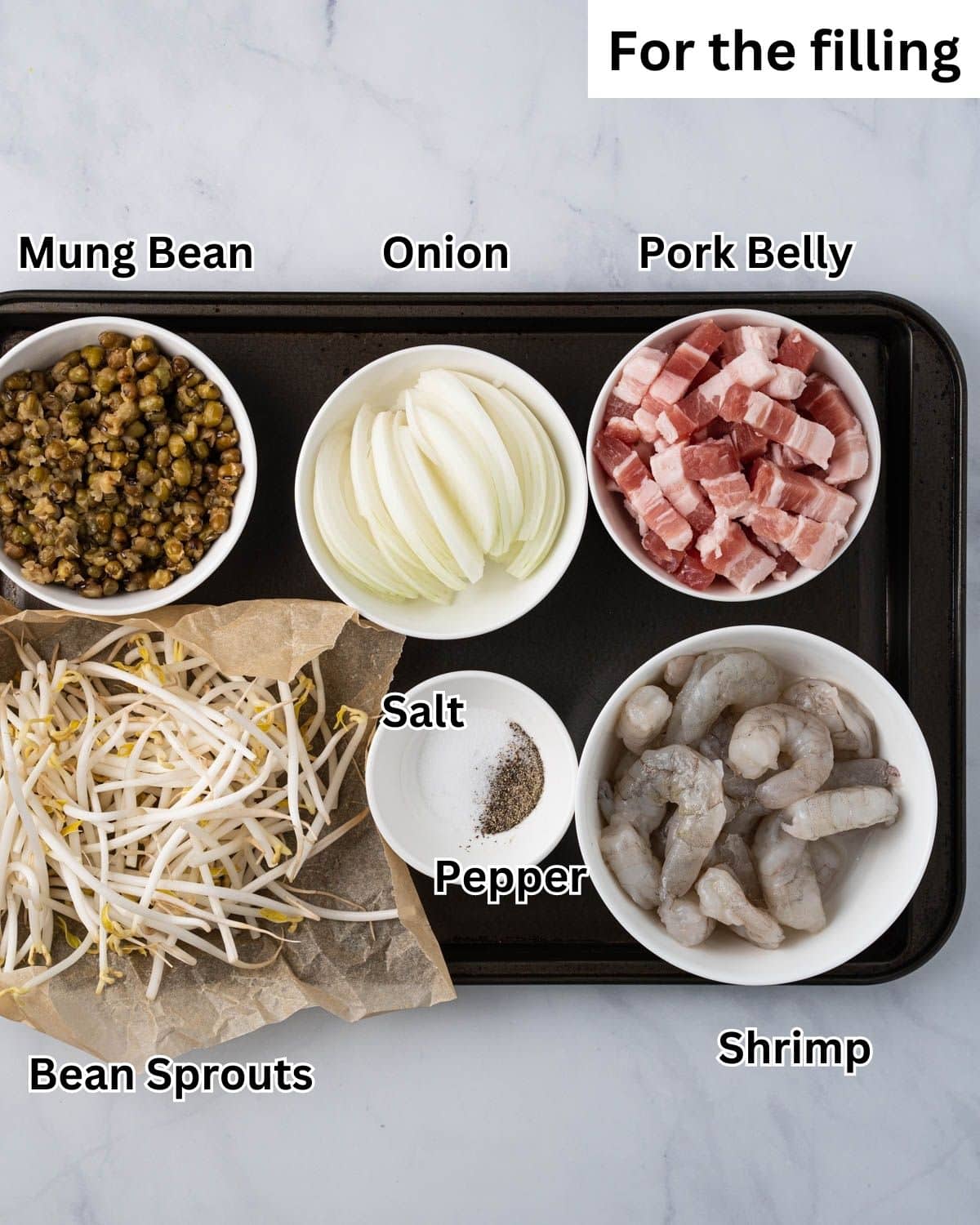
For the filling:
- Pork Belly: Cut into thin bite-size slices. You can also substitute this with pork loin, chicken, or any other protein.
- Shrimp: You’ll need about 3-4 large shrimp for each banh xeo.
- Onion: An aromatic to enhance the flavor of the banh xeo.
- Salt and Pepper: Used to season and marinate the shrimp and pork.
- Mung Beans: Used for added protein. This is optional.
How to make it
Step One: Cook the mung beans. Add the mung beans to a small saucepan with about 2 cups of water and set the pan over medium-high heat. Cover the pan, bring the water to a boil, and cook the beans until they’re soft enough to crush between two fingers, about 30 minutes. Remove the pan from the heat and set aside.
Step Two: Prepare the crepe batter. In a large bowl, mix together the entire bag of Mikko Prepared Mix Flour for Rice Pancake, cornstarch, turmeric powder, sugar, salt, beer (or club soda), coconut milk, warm water, and green onions. Set it aside and let it rest for at least 30 minutes (no longer than 2 hours) to let the flour “bloom”.


Step Three: Prepare the sauce. In a large bowl, combine water, fish sauce, lime juice, sugar, garlic cloves, and chili. Whisk until the sugar dissolves. Taste and adjust the seasoning as desired.
Step Four: Prepare the filling. In a large bowl, combine shrimp, pork, salt, and pepper.


Step Five: Cook the crepes. Preheat the frying pan on medium-high heat until hot (test with a few drops of water). Once it is hot, add 1 tablespoon of oil, 2 to 4 shrimp, 2 to 3 slices of pork belly, and a few slices of onions. Saute for 2-3 minutes until shrimp and pork are fully cooked. Then, spread the filling out evenly around the pan. Add more oil, if needed.


Step Six: Add about ½ to ⅔ cup of batter (depending on the size of your pan), lift the pan, and move your wrist in a circular motion to quickly swirl the batter around to spread the batter evenly across the entire pan. The goal is a thin and crispy layer. Cook for 3-4 minutes. (Note: Depending on your stove, you may need to adjust the heat so that it doesn’t burn. Medium and slow is best.)
Step Seven: Add a handful of bean sprouts and a tablespoon of mung beans to the top half of the crepe. Drizzle a little oil all around the edge of the pan and let it cook for an additional 2-3 minutes until it is crispy at the bottom.

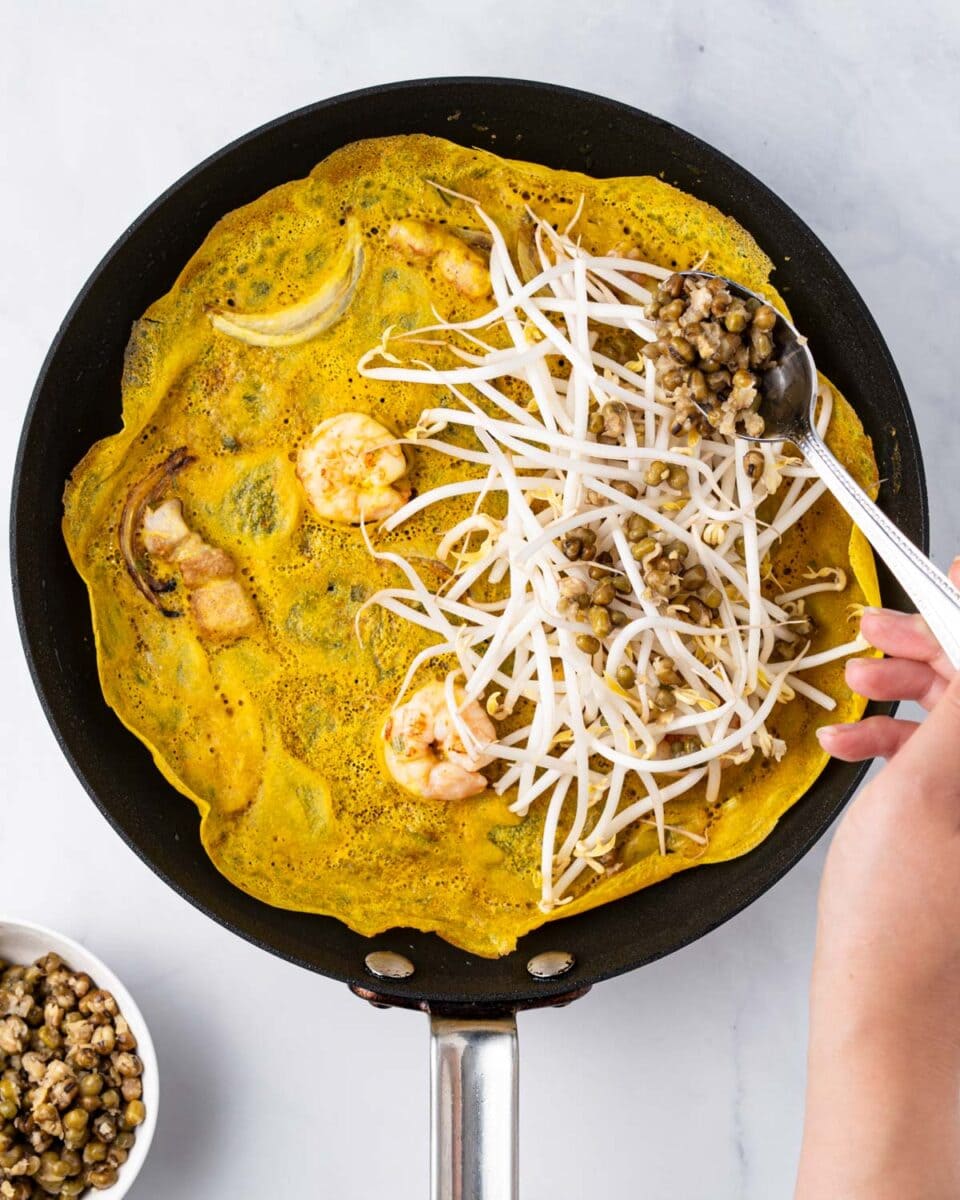

Step Eight: Then, fold the unfilled portion of the crepe in half. Transfer the crepe to a serving plate and repeat the steps to cook the remaining crepes.
Step Nine: Serve the crepes. Wrap the fresh greens around a bite-size piece of crepe and dip into the sauce. Enjoy!

Tips for making the best banh xeo
Here are some tips to help you make the best banh xeo:
- Preheat the pan: Ensure that your pan is properly preheated before adding the batter. This helps to achieve a crispy texture and prevents the pancake from sticking.
- Thin and even batter: Make sure your batter is thin and smooth. It should have a consistency similar to that of thin crepe batter. If the batter is too thick, your banh xeo might turn out dense instead of crispy. Use the correct measuring tools. Use a liquid measuring cup to measure the wet ingredients and a dry measuring cup to measure the dry ingredients. If needed, adjust the consistency by adding a little more water.
- Use coconut milk: Coconut milk adds richness and flavor to the banh xeo batter. It enhances the taste and helps in achieving a crisp texture. Make sure to use good quality coconut milk for the best results.
- Let the batter rest: Allowing the batter to rest for at least 30 minutes before cooking allows the flavors to meld and the starches to hydrate fully. This resting time contributes to a lighter texture.
- Properly grease the pan: Ensure that your pan is adequately greased before pouring the batter. Use a brush or a paper towel to evenly spread a thin layer of oil. This prevents the pancake from sticking and aids in achieving a crispy finish.
- Cook over medium to medium-high heat: Banh xeo is best cooked over medium heat. This allows the pancake to cook evenly without burning. Adjust the heat as needed during the cooking process to maintain the desired crispiness.
- Customize the fillings: While shrimp and pork are common fillings for banh xeo, feel free to experiment and add other ingredients according to your preference. Bean sprouts, green onions, and fresh herbs like mint, cilantro, and perilla leaves add freshness and enhance the flavors.
- Serve immediately: Banh xeo is best enjoyed fresh and hot off the pan. Serve it immediately after cooking to ensure it retains its crispiness.
- Dipping sauce: The dipping sauce is an essential component of banh xeo. Prepare a tangy and savory dipping sauce with fish sauce, lime juice, sugar, minced garlic, and chili (if desired). Adjust the flavors to your liking and use it to enhance the taste of the banh xeo.
Remember, practice makes perfect. Don’t be discouraged if your first attempt isn’t flawless. With time and experience, you’ll be able to master the art of making delicious banh xeo.
Why do I need to let the banh xeo batter rest?
Allowing the banh xeo batter to rest before cooking is an important step in the preparation process. Resting the batter serves several purposes that contribute to achieving optimal results.

Hydration and Consistency: Resting the batter allows the rice flour and other ingredients to fully hydrate. This hydration process ensures that the batter reaches a smooth and consistent texture. It gives the flour particles time to absorb the liquid, resulting in a cohesive batter that is easier to work with.
Flavor Development: Resting the batter allows the flavors to meld together and develop. The ingredients, such as turmeric powder and coconut milk, have time to infuse and harmonize, enhancing the overall taste of the banh xeo. This resting period allows the flavors to marry, creating a more flavorful and well-balanced pancake.
Starch Activation: Resting the batter allows the starches in the rice flour to activate. This starch activation contributes to the desired texture of the banh xeo. It helps create a crispy exterior while maintaining a soft and tender interior.
Improved Texture: Resting the batter gives time for air bubbles to dissipate, resulting in a smoother and more even texture when cooking. It allows the gluten-free batter to relax and reduce the risk of a tough or rubbery pancake.
Batter Thickness Adjustment: Resting the batter gives you an opportunity to assess its consistency. If the batter seems too thick after resting, you can add a bit more water to achieve the desired thinness. This adjustment helps create a delicate and lacy texture when the banh xeo is cooked.
Overall, resting the banh xeo batter allows for better hydration, flavor development, starch activation, improved texture, and the ability to adjust the consistency. It is a critical step in the process that helps ensure your banh xeo turns out delicious and of high quality.
Why is my banh xeo not crispy?
If your banh xeo is not turning out crispy, there could be a few possible reasons:
- Insufficient heat: Crispy banh xeo requires a hot pan. Make sure your pan is preheated adequately before pouring the batter. The pan should be hot enough to sizzle when the batter is added. Insufficient heat can result in the pancake not crisping up properly. Preheat the pan for at least 3 minutes and add a few drops of water to test if it is hot enough.
- Thick batter: The consistency of the batter plays a crucial role in achieving a crispy texture. If your batter is too thick, it can result in a denser pancake that doesn’t crisp up well. Ensure that your batter is thin and similar to the consistency of thin crepe batter. If needed, add a bit more water to achieve the right consistency.
- Insufficient oil: Properly greasing the pan with enough oil is important to prevent sticking and aid in achieving a crispy texture. Make sure the pan is evenly coated with a thin layer of oil before pouring the batter. You can use a brush or a paper towel to spread the oil evenly.
- Overcrowding the pan: If you pour too much batter or overcrowd the pan with too much filling, it can affect the crispiness. Ensure that you have enough space between the filling to have enough room to crisp up.
- Cooking time and technique: The cooking time and technique are crucial for achieving crispiness. Cook the banh xeo on medium heat to allow it to cook through and develop a crisp exterior. Low and slow will ensure crispy banh xeo.
- Moist fillings: If you’re adding ingredients with a high moisture content, such as bean sprouts or vegetables, they can release moisture during cooking, making it less crispy. Season the shrimp and pork with dry seasoning instead of sauces. Consider reducing the moisture content of fillings by adding the bean sprouts at the end.
By addressing these possible issues, you should be able to improve the crispiness of your banh xeo. Remember that practice and experimentation will help you perfect the technique over time.
How to eat it
Banh xeo is traditionally served with a variety of accompaniments that enhance its flavors and textures. Here are some common items to serve with banh xeo:
- Dipping Sauce (Nuoc mam or nuoc cham): A tangy and savory Vietnamese dipping sauce is a must-have accompaniment for banh xeo. Prepare a dipping sauce by combining fish sauce, water, lime juice, sugar, minced garlic, and minced chili (optional). Adjust the ingredients to your taste preferences. The dipping sauce adds a delightful contrast of flavors to the crispy pancake.
- Fresh Herbs: Banh xeo is typically served with a selection of fresh herbs. Popular options include mint leaves, cilantro, perilla leaves, or Thai basil. The herbs add a refreshing aroma and freshness to each bite. Arrange a platter of fresh herbs on the table for diners to customize their banh xeo by adding herbs to their rolls.
- Lettuce Leaves: Lettuce leaves are commonly used as wrappers for banh xeo. They add a crisp and refreshing element to each bite. Place a bowl of lettuce leaves on the table, allowing diners to wrap pieces of banh xeo, along with herbs and other fillings, to create flavorful bundles.
- Rice Paper Wrappers: In some regions of Vietnam, banh xeo is served with rice paper wrappers. These thin, translucent wrappers are soaked in water to soften them, and then diners wrap pieces of banh xeo, along with herbs and fillings, in the rice paper. This adds a fun and interactive element to the dining experience.
- Pickled Vegetables: Pickled vegetables, such as carrots and daikon radishes, are often served alongside banh xeo. The tangy and crunchy pickles provide a refreshing contrast to the rich and crispy pancake. You can make pickles at home or find them at Asian grocery stores.

Remember, the choice of accompaniments can vary based on personal preferences and regional variations. Feel free to experiment and create your own combinations.
Frequently Asked Questions and Answers
“Banh xeo” translates to “sizzling cake” or “sizzling pancake” in English. The term “banh” refers to a variety of Vietnamese cakes or pastries, while “xeo” is an onomatopoeic word representing the sizzling sound that the batter makes when it hits the hot pan. So, the name “banh xeo” reflects the characteristic sizzling sound and the crispy texture of the pancake when it is cooked.
Yes, you can prepare the filling and marinate the shrimp and pork the night before. The batter can be made 2 hours in advance. I would not suggest leaving the batter out any longer than that since the carbonation from the beer/club soda will go flat. I can vouch for this based on personal experience. My initial attempt turned out to be a FAIL since I left the batter sitting for 4 hours. The result was soggy banh xeo.

What to do with leftovers
If you have leftover batter, try making banh khot, which uses the same batter.
Allow it to cool
If you have leftover banh xeo that you would like to store for later consumption, let the cooked banh xeo cool down to room temperature before storing them. This helps prevent condensation and keeps them from becoming soggy when stored.
To prevent it from sticking together, place a sheet of parchment paper between each pancake. This ensures that they can be easily separated without tearing or sticking when you want to reheat them.
Refrigerate
Place the separated banh xeo in an airtight container. Choose a container that is the right size to accommodate the pancakes without squishing them. Seal the container tightly to maintain freshness.
If you plan to consume the banh xeo within a day or two, store them in the refrigerator. They can be refrigerated for up to two days.
Freeze
If you want to store the banh xeo for an extended period, freezing is an option. Place the container of banh xeo in the freezer, ensuring it is well-sealed. Frozen banh xeo can typically be stored for up to a month.
Reheat
When you’re ready to enjoy the stored banh xeo, it’s best to reheat them in an oven or toaster oven to restore their crispiness. Preheat the oven to a low temperature (around 350°F/177°C) and heat the banh xeo for a few minutes until they are warmed through and crispy. Avoid reheating them in a microwave, as it can make the pancakes soggy.
It’s important to note that while storing banh xeo is possible, the texture may not be as perfect as freshly made ones. The crispiness may diminish slightly during storage, but reheating can help revive them to some extent.
RECIPE

Bánh Xèo (Vietnamese Sizzling Crepes)
Ingredients
Batter
- 3½ cups Mikko Prepared Mix Flour for Rice Pancake (Bot Banh Xeo Huong Xua or Rice Flour)
- 2 tablespoons cornstarch
- 1 ½ tablespoons turmeric powder
- ½ teaspoon sugar
- ½ teaspoon salt
- 3 cups beer (or unsweetened club soda)
- 1 cup coconut milk
- ⅓ cup warm water (100℉ – 110℉)
- 3 green onions, chopped
Filling
- ⅔ pound large shrimp (about 28), peeled and deveined
- ⅔ pound pork belly, cut into thin strips
- 2 tablespoon vegetable oil, divided
- ½ teaspoon salt
- ¼ teaspoon ground pepper
- 1 yellow onion, thinly sliced
- bean sprouts
- 1 cup dried mung beans
- Assorted greens (lettuce, Thai basil, mint, perilla leaves)
Dipping Sauce
- 2 cups water
- ⅓ cup fish sauce
- ¾ cup lime juice
- ⅓ cup sugar
- 4 garlic cloves, minced
- 1-2 bird's eye or Thai chili, finely chopped
Instructions
- To cook the mung beans: Add the mung beans to a small saucepan with about 2 cups of water and set the pan over medium-high heat. Cover the pan, bring the water to a boil, and cook the beans until they're soft enough to crush between two fingers, about 30 minutes. Remove the pan from the heat and set aside.
- To prepare the crepe batter: In a large bowl, mix together the entire bag of Mikko Prepared Mix Flour for Rice Pancake, cornstarch, turmeric powder, sugar, salt, beer (or club soda), coconut milk, warm water, and green onions. Set it aside and let it rest for at least 30 minutes (no longer than 2 hours) to let the flour "bloom".
- To prepare the sauce: In a large bowl, combine water, fish sauce, lime juice, sugar, garlic cloves, and chili. Whisk until the sugar dissolves. Taste and adjust the seasoning as desired.
- To prepare the filling: In a large bowl, combine shrimp, pork, salt, and pepper.
- To cook the crepes: Preheat the frying pan on medium-high heat until hot (test with a few drops of water). Once it is hot, add 1 tablespoon of oil, 2 to 4 shrimp, 2 to 3 slices of pork belly, and a few slices of onions. Saute for 2-3 minutes until shrimp and pork are fully cooked. Then, spread the filling out evenly around the pan. Add more oil, if needed.
- Add about ½ to ⅔ cup of batter (depending on the size of your pan), lift the pan, and move your wrist in a circular motion to quickly swirl the batter around to spread the batter evenly across the entire pan. The goal is a thin and crispy layer. Cook for 3-4 minutes. (Note: Depending on your stove, you may need to adjust the heat so that it doesn't burn.)
- Add a handful of bean sprouts and a tablespoon of mung beans to the top half of the crepe. Drizzle a little oil all around the edge of the pan and let it cook for an additional 2-3 minutes until it is crispy at the bottom.
- Then, fold the unfilled portion of the crepe in half. Transfer the crepe to a serving plate and repeat the steps to cook the remaining crepes.
- To serve the crepes: wrap the fresh greens around a bite-size piece of crepe and dip into the sauce. Enjoy!


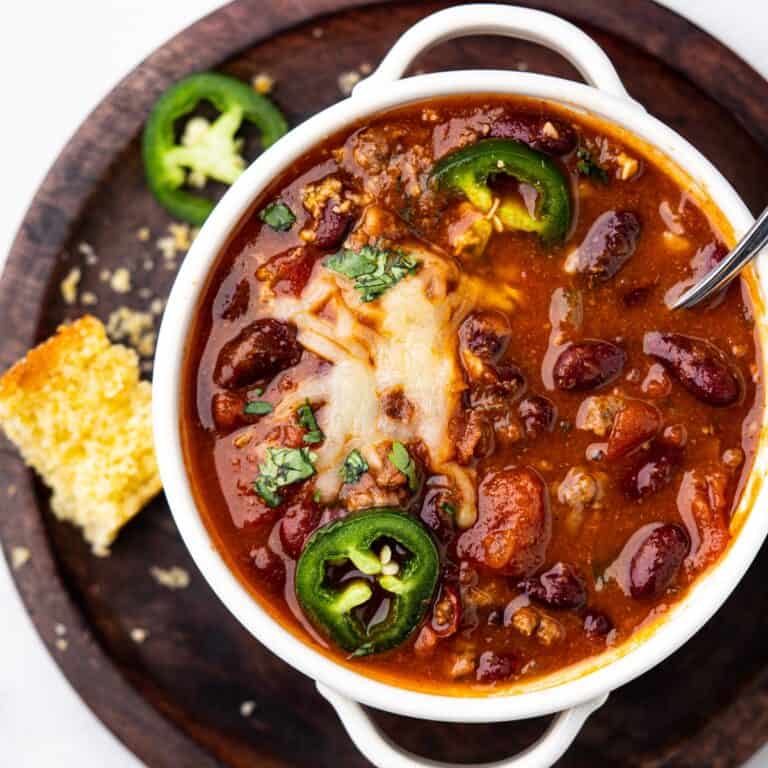
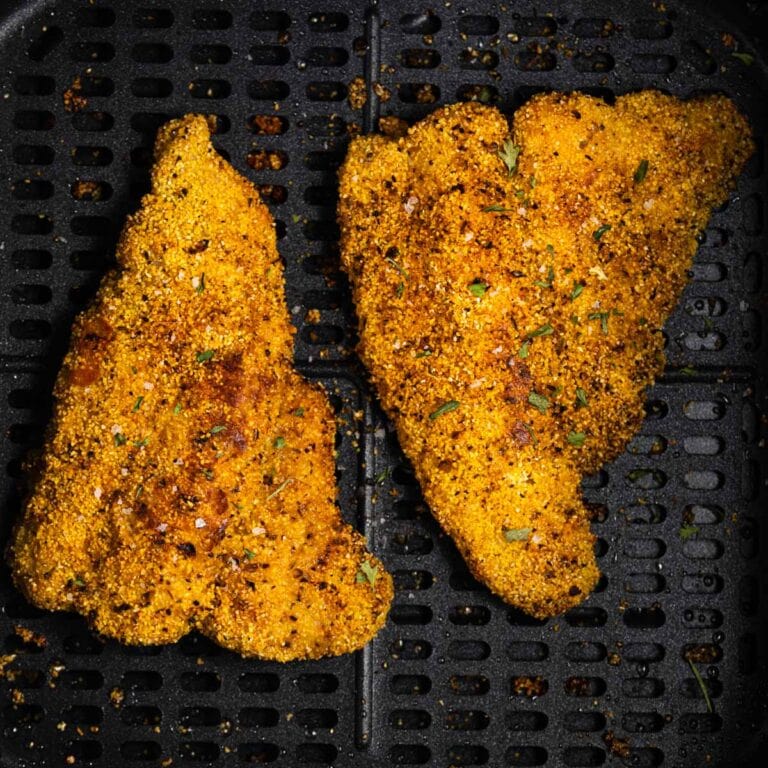
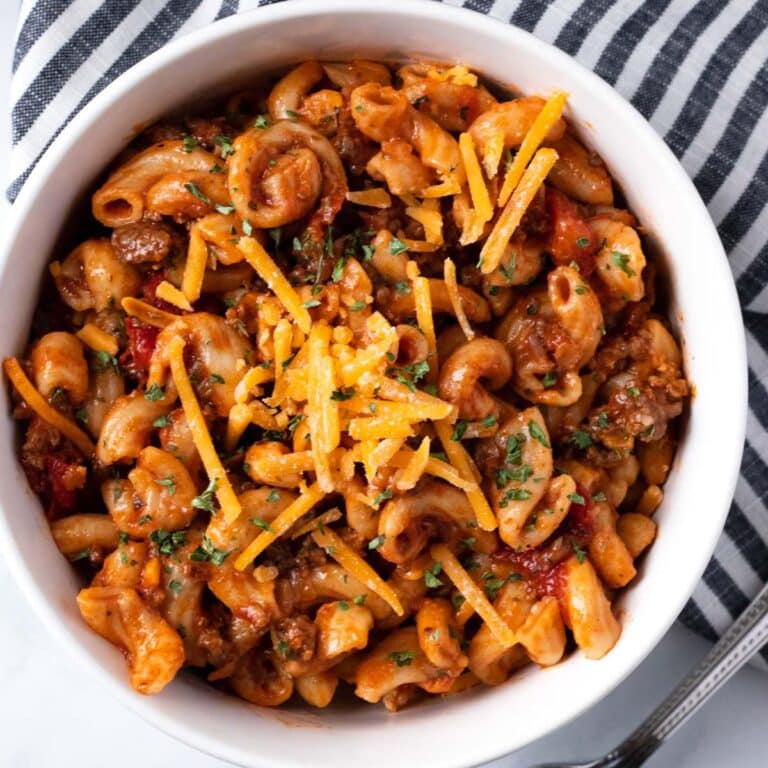

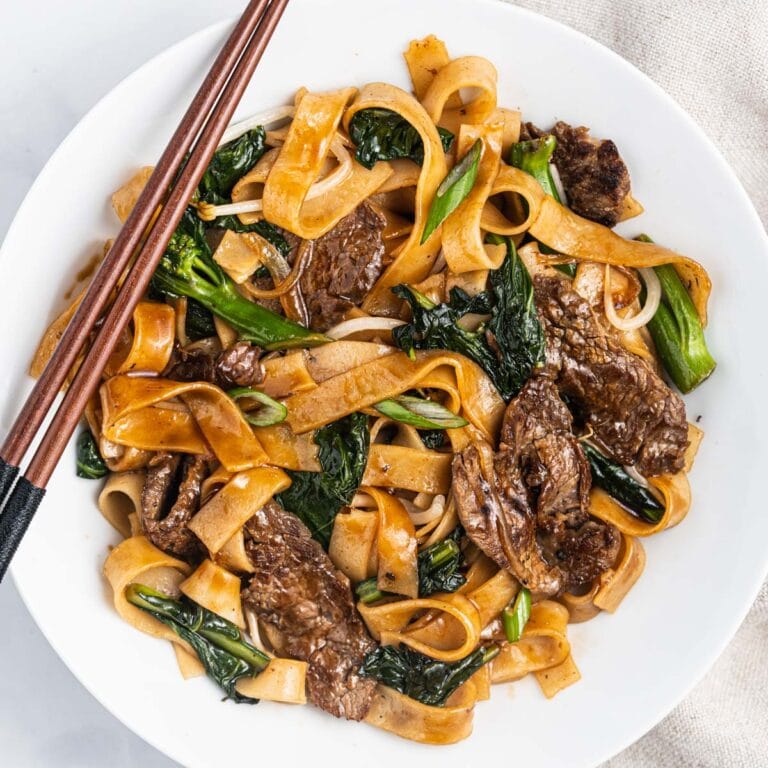
These are so light and fluffy and flavorful! Will be making again.
I have only tried this dish at a Vietnamese restaurant before and have always wanted to try it at home. Thanks for your detailed recipe and all the pics, it was very helpful as I was a bit intimidated by the process at first. I used rice flour and turmeric spice instead of the ready mix.
Fabulous crepe- Yum
Your site makes great food easy
I love Vietnamese crepes! These look so delicious